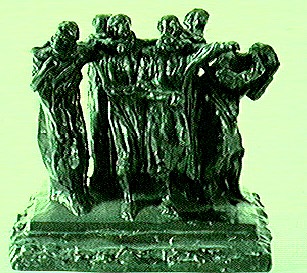
This monumental work commemorates an incident in the Hundred Years War between the English and the French. In 1347, the city of Calais was besieged by the English, led by King Edward III. Edward demanded the surrender of the city. To stop any further loss of life, the oldest Burgher, Eustache de Saint Pierre, led a group of six of Calais' leading citizens to the English. However, thanks to the intercession of Edward's wife, Phillippa, the lives of all six Burghers were spared.
After submitting the maquette (illustrated below), Rodin was awarded the commmission to complete the monument. The original design shows the work mounted on a pedestal which was usual for heroic monuments at the time. However, Rodin quickly abandoned this type of monumental presentation in favour of a more realistic placement of the Burghers at ground level, with space between each figure. In this way, Rodin pioneered a new monumental form which was psychologically realistic in its concept and presentation. As he is reported to have said to his friend and biographer, Paul Gsell,
"I have not shown them grouped in a triumphant apotheosis, such glorification of their heroism would not have corresponded to anything real. On the contrary, I have, as it were, threaded them one behind the other, because in the indecision of the last inner combat which ensues between their cause and their fear of dying, each of them is isolated in front of their conscience."
The Gallery now owns re casts not only of the original maquette but also of two of the life size nude studies (Ref 6b and 6c), and four of the six clothed figures used in the final monument(Ref.6d to 6g). The production of all of these bronzes was supervised and authorised by the Musée Rodin, at the Hotel Biron, Paris.
NOTE: For biographical details of Auguste Rodin, see also student project by Kathleen M Treacy, http://"bohm.anu.edu.au/~t9400687/homepage.html

Map Ref.6 (Item a) Usually on display inside the Gallery building, on the ramp leading from Temporary Exhibition Gallery No.10 to The Brasserie Restaurant. The maquette was originally made of clay but in 1970 it was cast in bronze, under the supervision of the Musée Rodin.

Map Ref.6 (Item b) The Winter Garden. Jeanne de Fiennes is the figure on the left, with his left heel raised.
Map Ref.6 (Item c) The Winter Garden. Jean d'Aire is on the right with both feet firmly on the ground. In the final work, d'Aire's hands will hold the key to the city.
From these full scale models, it is clear the Rodin was primarily interested in creating the human form beneath the heavy sackcloth garments. The awkward, frozen poses of these nudes, exemplified by the tense musculature of their faces, betrays the state of fear and foreboding experienced by each man.
When making these models, Rodin made no effort to conceal the aids he used during the modelling process. For example, there is evidence that a wooden strut supported Jean d"Aire's right arm.
The Gallery currently owns a clothed bronze of Jean d'Aire, as illustrated below, but not of Jeane de Fiennes.

Map Ref.6 (Item d) The Winter Garden.
Pierre de Wiessant, is the first figure illustrated on the left. De Wiessant has his head bowed to his right, and has raised his right arm from the elbow, as if to beg for mercy. When considering the meaning of both the head and arm position, it is clear that the figure is expressing despair and at the same time resignation. According to Rodin's interpretation of the Burgher's story, de Wiessant would have felt that he has been overwhelmed by circumstances beyond his control.
Map Ref.6 (Item e) The Winter Garden.
Although the leader of the Burghers, Rodin has placed Eustace de Saint Pierre in second place. De Saint Pierre was the oldest of the Burghers and so his position as elder statesmen has been emphasised by a beard. As the Burghers walk to meet their fate, de Saint Pierre's posture, the bowed head and shoulders, express his grief and humility with a quiet dignity.
Map Ref.6 (Item f) The Winter Garden.
The gate to the medieval city of Calais would have been made of heavy wooden beams. Even though the key to such a gate would have been large, Rodin has exagerated the weight and the tension in the figure, by the position of the hands which have been lowered to just below the knees. As he trudges along with the Burghers, holding the key, Jean d'Aire is grimly resigned to his fate.
Map Ref.6 (Item g) The Winter Garden.
Andrie d'Andres clasps his deeply bowed head between both hands. The posture expresses an attitude of utter grief and despair.
Rodin could have selected many scenes from the legend of "The Burghers of Calais". However, for maximum emotional effect, he selected the moment when they are setting out, bound with rope and humiliated. The result is a powerful memorial in honour of these men and the city of Calais.